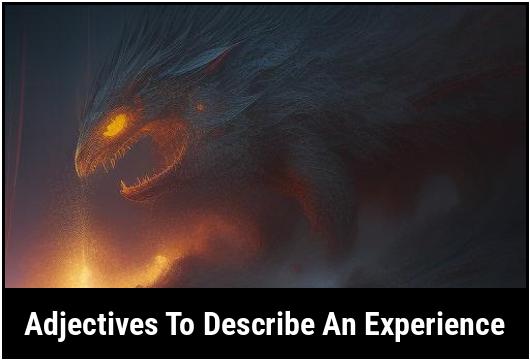- You are here:
- Home »
- adjectives
- » 41 Adjectives To Describe An Experience

41 Adjectives To Describe An Experience
When it comes to describing experiences, using the right adjectives can help evoke emotions, paint vivid pictures, and convey the depth of these moments. Whether it’s a thrilling adventure, a serene vacation, or a profound learning experience, adjectives play a crucial role in capturing the essence of an event. This article will delve into the importance of using adjectives to describe experiences, how to choose the right adjectives, and the various types of adjectives suitable for different types of experiences.
Key Takeaways
- Adjectives are essential for providing vivid and detailed descriptions of experiences.
- Choosing the right adjectives can elicit specific emotions, highlight certain aspects, and set the tone for the overall experience.
- Different types of experiences might call for different types of adjectives, from sensory descriptors to emotional qualifiers.
Adjectives To Describe An Experience
1. Exhilarating
An exhilarating experience is one that leaves us feeling invigorated and thrilled. It often involves a sense of danger or excitement, such as skydiving or driving a race car. The adrenaline rush and sheer joy of these moments make them truly unforgettable.
2. Tranquil
A tranquil experience is peaceful and calm, providing a sense of serenity and relaxation. Imagine sitting by a secluded lake or taking a leisurely stroll through a beautiful garden. These moments allow us to disconnect from the chaos of everyday life and find inner peace.
3. Enchanting
An enchanting experience captivates and mesmerizes us. It transports us to a world where magic and wonder flourish. Perhaps it’s witnessing a breathtaking sunset or getting lost in a mesmerizing piece of music. These enchanting moments leave us spellbound and filled with awe.
4. Hilarious
A hilarious experience is one that’s full of laughter and joy. It might involve a funny story, a comedy show, or simply sharing humorous moments with friends. Laughter is indeed the best medicine, and these experiences provide a much-needed dose of happiness.
5. Empowering
An empowering experience instills a sense of confidence, strength, and resilience. Overcoming challenges and accomplishing personal goals often evoke this feeling. Whether it’s completing a marathon or delivering a successful presentation, these experiences propel us forward and make us believe in our capabilities.
6. Breathtaking
A breathtaking experience is awe-inspiring and leaves us momentarily breathless. It might involve witnessing the grandeur of nature, like standing atop a mountain or gazing at the vastness of the ocean. These moments remind us of the immense beauty this world holds.
7. Nostalgic
A nostalgic experience takes us on a journey back in time. It evokes a deep sense of longing or wistfulness for the past. Hearing a favorite song from childhood or visiting a place filled with childhood memories can evoke strong feelings of nostalgia.
8. Transformative
A transformative experience alters our perspective, beliefs, or even our very selves. It pushes us outside of our comfort zones and challenges us to grow. Traveling to a new country, learning a new skill, or reading a thought-provoking book can all be transformative experiences.
9. Inspiring
An inspiring experience fuels our creativity and motivation. It might involve witnessing an awe-inspiring performance, hearing an impactful speaker, or reading an enlightening article. These experiences ignite our inner fire and encourage us to chase our dreams.
10. Mesmerizing
A mesmerizing experience holds us under its spell, captivating our senses and attention. It might be a stunning art exhibition, a dazzling fireworks display, or a talented street performer. We become completely absorbed in the moment, unable to look away.
11. Thrilling
A thrilling experience fills us with a sense of excitement and anticipation. It might involve riding a roller coaster, bungee jumping, or trying an extreme sport. The rush of adrenaline and the feeling of being alive make these experiences truly unforgettable.
12. Relaxing
A relaxing experience provides a much-needed respite from the demands of everyday life. It might involve lounging on a beach, getting a massage, or taking a long bath. These moments of relaxation allow us to unwind and rejuvenate our minds and bodies.
13. Exquisite
An exquisite experience is characterized by its refinement, elegance, and beauty. It might involve savoring a delectable meal, attending a luxurious event, or witnessing a flawless performance. These experiences indulge our senses and leave a lasting impression.
14. Adventurous
An adventurous experience is filled with excitement, novelty, and exploration. It might involve embarking on a hiking expedition, exploring a new city, or trying a new cuisine. These experiences awaken our sense of curiosity and allow us to embrace the unknown.
15. Heartwarming
A heartwarming experience touches us deeply and evokes feelings of warmth and affection. It might involve witnessing an act of kindness, spending time with loved ones, or being part of a supportive community. These experiences remind us of the power of compassion and connection.
16. Majestic
A majestic experience is characterized by its grandeur and magnificence. It might involve visiting a majestic palace, witnessing a stunning waterfall, or gazing at a star-studded night sky. These experiences remind us of the awe-inspiring wonders that exist in the world.
17. Uplifting
An uplifting experience elevates our spirits and fills us with positivity and hope. It might involve attending a motivational workshop, reading an inspiring book, or spending time in nature. These experiences recharge our batteries and remind us of the beauty of life.
18. Whimsical
A whimsical experience is characterized by its playfulness and imagination. It might involve attending a masquerade ball, visiting a whimsical art installation, or reading a fantastical book. These experiences transport us to a world free from constraints and filled with wonder.
19. Sensational
A sensational experience is extraordinary and evokes strong emotions. It might involve attending an exhilarating concert, watching a breathtaking sunset, or taking part in an electrifying sports event. These experiences leave us enchanted and yearning for more.
20. Enlightening
An enlightening experience expands our knowledge, understanding, and perspectives. It might involve attending a thought-provoking lecture, engaging in a deep conversation, or visiting a historical site. These experiences broaden our horizons and ignite our quest for learning.
21. Memorable
A memorable experience leaves a lasting imprint in our minds. It might involve celebrating a special occasion, traveling to a dream destination, or achieving a personal milestone. These moments become treasured memories that we cherish for a lifetime.
22. Exhilarating
An exhilarating experience is one that leaves us feeling invigorated and thrilled. It often involves a sense of danger or excitement, such as skydiving or driving a race car. The adrenaline rush and sheer joy of these moments make them truly unforgettable.
23. Serene
A serene experience provides a calm and peaceful environment where one can find tranquility. It might involve taking a leisurely walk in a park, meditating on a mountaintop, or gazing at a starry night sky. These experiences offer a haven of peace and quietude.
24. Awe-Inspiring
An awe-inspiring experience fills us with a sense of awe and wonder. It might involve witnessing a magnificent natural phenomenon, such as the Northern Lights or a solar eclipse. These experiences remind us of the marvels of our universe and the beauty it holds.
25. Joyful
A joyful experience is one that brings happiness and delight. It might involve celebrating a special occasion, spending quality time with loved ones, or achieving a personal goal. These moments fill our hearts with pure and unadulterated joy.
26. Fascinating
A fascinating experience captivates our attention and sparks our curiosity. It might involve delving into a captivating subject, exploring a new culture, or observing a unique wildlife encounter. These experiences broaden our horizons and ignite our thirst for knowledge.
27. Invigorating
An invigorating experience energizes and revitalizes us. It might involve taking a refreshing swim in the ocean, going for a morning jog, or practicing yoga. These experiences recharge our batteries and leave us feeling refreshed and invigorated.
28. Enriching
An enriching experience enhances our knowledge, skills, or personal growth. It might involve attending a workshop, learning a new language, or volunteering for a meaningful cause. These experiences provide us with valuable insights and transform us into better versions of ourselves.
29. Soothing
A soothing experience brings comfort and relief. It might involve listening to calming music, receiving a gentle massage, or sipping a hot cup of tea. These moments of tranquility provide solace and help us find solace amidst the chaos of life.
30. Enthralling
An enthralling experience captivates our attention and holds us spellbound. It might involve attending a gripping theater performance, watching an engaging film, or reading an enthralling novel. These experiences transport us to different worlds and leave us hungry for more.
31. Delightful
A delightful experience is characterized by its charm and pleasure. It might involve indulging in a delicious meal, visiting a vibrant market, or watching a delightful sunset. These moments fill us with joy and remind us to savor the simple pleasures in life.
32. Mesmerizing
A mesmerizing experience holds us under its spell, captivating our senses and attention. It might be a stunning art exhibition, a dazzling fireworks display, or a talented street performer. We become completely absorbed in the moment, unable to look away.
33. Riveting
A riveting experience grabs our attention and keeps us engaged. It might involve attending a suspenseful play, watching an intense sports match, or reading a gripping page-turner. These experiences create a sense of excitement and make us eager to see what unfolds next.
34. Harmonious
A harmonious experience brings together different elements in perfect balance. It might involve listening to a beautiful symphony, witnessing a flawless dance performance, or indulging in gourmet cuisine. These experiences remind us of the magic that happens when everything aligns seamlessly.
35. Reflective
A reflective experience encourages introspection and deep thought. It might involve taking a solitary walk in nature, spending time in contemplation, or writing in a journal. These moments allow us to ponder on life’s mysteries and gain insights into ourselves.
36. Impactful
An impactful experience leaves a significant impression and has a lasting effect on us. It might involve meeting an inspiring mentor, participating in a life-changing workshop, or reading an impactful book. These moments often shape our lives and create a profound shift in perspective.
37. Harmonious
A harmonious experience brings together different elements in perfect balance. It might involve listening to a beautiful symphony, witnessing a flawless dance performance, or indulging in gourmet cuisine. These experiences remind us of the magic that happens when everything aligns seamlessly.
38. Exhilarating
An exhilarating experience is one that leaves us feeling invigorated and thrilled. It often involves a sense of danger or excitement, such as skydiving or driving a race car. The adrenaline rush and sheer joy of these moments make them truly unforgettable.
39. Tranquil
A tranquil experience is peaceful and calm, providing a sense of serenity and relaxation. Imagine sitting by a secluded lake or taking a leisurely stroll through a beautiful garden. These moments allow us to disconnect from the chaos of everyday life and find inner peace.
40. Majestic
A majestic experience is characterized by its grandeur and magnificence. It might involve visiting a majestic palace, witnessing a stunning waterfall, or gazing at a star-studded night sky. These experiences remind us of the awe-inspiring wonders that exist in the world.
41. Awe-Inspiring
An awe-inspiring experience fills us with a sense of awe and wonder. It might involve witnessing a magnificent natural phenomenon, such as the Northern Lights or a solar eclipse. These experiences remind us of the marvels of our universe and the beauty it holds.
Why Use Adjectives To Describe An Experience
Using adjectives to describe an experience enhances communication by adding depth, color, and nuance to the narrative. Rather than simply stating that an experience was "good" or "bad," the use of adjectives allows for a more elaborate and engaging portrayal.
Adjectives have the power to evoke specific emotions, sensations, and perspectives that provide a richer understanding of an experience. Whether it’s conveying the exhilaration of a rollercoaster ride, the tranquility of a sunset, or the profound impact of a historical site, well-chosen adjectives can make the experience come alive for the audience.
Furthermore, using adjectives to describe an experience can create a lasting impression and help the storyteller connect with the listener or reader on a deeper level. By carefully selecting adjectives, one can effectively transport others into the same emotional and sensory space, fostering empathy and understanding.
How To Choose The Right Adjective To Describe An Experience
Selecting the appropriate adjectives to describe an experience involves considering various factors that contribute to the overall impact and essence of the event. Here are some considerations to keep in mind when choosing the right adjectives:
-
Identify the Dominant Emotions: Determine the primary sentiments associated with the experience. For instance, is it thrilling, peaceful, transformative, or nostalgic? Understanding the dominant emotions can guide the selection of adjectives that accurately capture these feelings.
-
Consider the Sensory Elements: Reflect on the sensory aspects of the experience. How did it look, sound, smell, taste, and feel? Incorporating sensory adjectives can bring a multi-dimensional quality to the description, making it more evocative and immersive.
-
Reflect on Intensity and Impact: Assess the intensity and impact of the experience. Was it profound, life-changing, momentous, or subtle? Choosing adjectives that convey the magnitude of the experience can effectively communicate its significance to others.
-
Capture Specific Details: Take note of specific details or unique characteristics of the experience. Whether it’s the architecture of a historic building, the acoustics of a music concert, or the aroma of a local cuisine, using detailed adjectives can paint a vivid and distinct picture for the audience.
-
Consider the Audience: Tailor the choice of adjectives based on the audience and their potential connection to the experience. Different audiences may resonate with different adjectives, so it’s essential to consider the perspective of the listener or reader.
By considering these factors, one can select adjectives that encapsulate the essence of the experience, effectively conveying its emotional impact and sensory richness to the audience.
Types Of Adjectives For Describing Experience
The selection of adjectives for describing experiences can encompass a wide range of categories, each serving a specific purpose in capturing the nuances of different types of events. Here are various types of adjectives suitable for describing experiences:
Sensory Adjectives
Sensory adjectives are particularly useful for describing experiences that involve sensory stimulation such as sight, sound, taste, smell, and touch. These adjectives help recreate the sensory aspects of an experience, making it more immersive and palpable for the audience. Some examples of sensory adjectives include:
- Visual: Stunning, vibrant, picturesque, radiant
- Auditory: Resonant, melodic, cacophonous, soothing
- Olfactory: Fragrant, aromatic, pungent, redolent
- Gustatory: Savory, zesty, succulent, bitter
- Tactile: Smooth, rough, velvety, gritty
By incorporating sensory adjectives, one can effectively convey the sensory landscape of an experience, allowing the audience to visualize and sense the event more vividly.
Emotional Adjectives
Emotional adjectives are pertinent for conveying the range of emotions associated with an experience. These adjectives capture the feelings, moods, and sentiments that define the emotional essence of the event. Depending on the nature of the experience, emotional adjectives can range from jubilant and exhilarating to poignant and contemplative. Examples include:
- Joyful: Exuberant, elated, jubilant, ecstatic
- Serene: Tranquil, peaceful, serene, calming
- Profound: Impactful, profound, stirring, poignant
- Rousing: Thrilling, exhilarating, electrifying, invigorating
- Melancholic: Wistful, mournful, melancholic, nostalgic
By incorporating emotional adjectives, one can effectively convey the emotional resonance of the experience, allowing the audience to empathize and connect with the sentiments evoked.
Descriptive Adjectives
Descriptive adjectives serve to highlight specific details, attributes, and characteristics of an experience. Whether it’s the physical surroundings, the ambiance, or the unique features of the event, descriptive adjectives add depth and specificity to the description. Examples include:
- Architectural: Ornate, grandiose, minimalist, futuristic
- Ambient: Lively, bustling, secluded, enchanting
- Culinary: Delectable, succulent, spicy, flavorful
- Historical: Ancient, storied, iconic, monumental
- Cultural: Authentic, vibrant, traditional, eclectic
By incorporating descriptive adjectives, one can provide a more comprehensive and detailed portrayal of the experience, allowing the audience to grasp the distinct elements that define it.
Qualitative Adjectives
Qualitative adjectives help convey the overall quality, impact, and significance of an experience. These adjectives capture the essence of the event in terms of its significance, value, and impact, offering a sense of scale and importance. Examples include:
- Transcendent: Transformative, transcendent, paradigm-shifting
- Impactful: Influential, pivotal, transformative, significant
- Momentous: Monumental, historic, epoch-making, landmark
- Sublime: Majestic, awe-inspiring, sublime, majestic
- Pivotal: Critical, crucial, decisive, pivotal
By incorporating qualitative adjectives, one can emphasize the overarching impact and significance of the experience, enabling the audience to appreciate its broader implications and importance.
Describing experiences using adjectives enriches storytelling, enhances communication, and fosters a deeper connection with the audience. By carefully selecting adjectives that capture the emotional, sensory, and qualitative aspects of an experience, one can evoke vivid imagery and convey the essence of the event with depth and nuance. From sensory adjectives that recreate the sights and sounds to emotional qualifiers that convey the mood and sentiment, the use of adjectives plays an integral role in articulating the richness of experiences. By understanding the importance of adjectives in describing experiences and exploring the various types of adjectives suited for different aspects of an experience, individuals can effectively convey the essence and impact of their experiences, creating lasting impressions and fostering emotional resonance with their audience.
Examples Of Adjectives For Different Types Of Experience
When it comes to describing an experience, choosing the right adjectives can make all the difference. Adjectives serve to add detail, color, and emotion to our descriptions, allowing us to paint a vivid picture for our readers or listeners. However, finding the perfect words to capture the essence of an experience can be challenging.
Experiences come in all shapes and forms, ranging from thrilling adventures to serene moments of tranquility. Let’s take a look at some adjectives that can effectively describe specific types of experiences:
1. Thrilling Experiences
- Exhilarating: This adjective conveys a sense of intense excitement and pleasure. It can be used to describe activities such as bungee jumping, skydiving, or riding a roller coaster.
- Heart-pounding: This adjective emphasizes the impact on one’s emotions or the physical response an experience elicits. It can be used to describe situations that induce a rapid heartbeat, such as a terrifying horror movie or a dangerous but thrilling sport like rock climbing.
- Electrifying: Use this adjective to describe experiences that give a strong sensation, often due to high levels of energy or anticipation. It can be applied to live concerts, sporting events, or action-packed adventures.
2. Peaceful Experiences
- Serene: This adjective describes experiences that are calm, peaceful, and free from disturbance. It is often used to describe settings like a tranquil beach, a quiet forest, or a peaceful meditation session.
- Tranquil: Similar to serene, this adjective evokes a sense of calm and tranquility. It can be used to describe experiences like a walk in a peaceful garden, a gentle boat ride on a calm lake, or the soothing sounds of rainfall.
- Harmonious: Use this adjective to describe experiences where everything falls into perfect balance and creates a feeling of inner peace. It can be used to describe moments of deep connection with nature, engaging in activities like yoga or meditation, or listening to soothing music.
3. Memorable Experiences
- Unforgettable: This adjective emphasizes the lasting impact of an experience. It suggests that the memory will be etched in one’s mind for a long time. It can be used to describe events like a surprise party, a breathtaking sunset, or a life-changing trip.
- Extraordinary: Use this adjective to describe experiences that are beyond the ordinary or usual. It conveys a sense of uniqueness and exceptional quality. It can be applied to encounters with extraordinary people, witnessing extraordinary sights, or engaging in extraordinary activities.
- Momentous: This adjective is used to describe experiences that are of great importance or that mark a significant event. It suggests a sense of significance and can be applied to experiences such as graduations, weddings, or historical moments.
4. Challenging Experiences
- Grueling: This adjective suggests that an experience is physically or mentally demanding, often causing exhaustion or fatigue. It can be used to describe rigorous physical workouts, mentally intensive tasks, or demanding competitions.
- Daunting: Use this adjective to describe experiences that are intimidating or seem difficult to overcome. It implies a sense of fear or apprehension. It can be applied to situations like public speaking, starting a new job, or facing a major life decision.
- Formidable: This adjective describes experiences that present a great challenge or require considerable effort. It suggests that the obstacles to overcome are significant. It can be used to describe tasks that involve intense problem-solving, overcoming adversity, or pursuing ambitious goals.
These are just a few examples of adjectives that can be used to describe different types of experiences. The key is to select words that accurately capture the essence of the experience and evoke the desired emotions in the reader or listener.
Common Mistakes In Using Adjectives To Describe Experience
When using adjectives to describe experiences, it is essential to avoid common mistakes that can diminish the impact of your descriptions or lead to confusion. Let’s explore some of these mistakes and how to avoid them:
1. Vague Or Ambiguous Adjectives
Using adjectives that are too general or vague can weaken the impact of your descriptions and leave your audience unsure of what exactly you are trying to convey. For example, using adjectives like "nice," "good," or "bad" fail to provide the necessary detail and specificity.
To overcome this, strive for more precise adjectives that accurately convey the unique qualities or characteristics of the experience. Instead of saying an experience was "nice," you could describe it as "gratifying," "uplifting," or "enjoyable." By choosing more specific adjectives, you provide a clearer picture of the experience and engage your audience more effectively.
2. Overusing Superlatives
While superlatives such as "amazing," "incredible," or "unbelievable" can be useful in emphasizing the exceptional nature of an experience, overusing them can diminish their impact. If every experience is described as "the best" or "unforgettable," it dilutes the power of these adjectives and makes them less meaningful.
Instead, save superlatives for experiences that genuinely deserve them and use other adjectives to convey varying degrees of intensity or importance. By using a range of adjectives, you can create a more nuanced and authentic description of an experience.
3. Failing To Consider Context
The context in which an experience occurs can significantly influence the choice of adjectives used to describe it. For example, an adjective that may be appropriate for a relaxing vacation experience may not be suitable for describing a high-intensity adventure.
When selecting adjectives, consider the specific context of the experience and use words that align with that context. This ensures that your descriptions accurately reflect the nature of the experience and resonate with your audience.
4. Ignoring The Five Senses
One effective way to describe an experience in detail is to engage all five senses – sight, sound, taste, touch, and smell. Neglecting any of these senses can result in incomplete descriptions that fail to fully immerse the reader or listener in the experience.
To avoid this, consider the sensory elements of the experience and incorporate relevant adjectives that evoke these senses. For instance, if describing a delicious meal, include adjectives that describe the taste, aroma, and visual appeal of the food.
By avoiding these common mistakes, you can elevate your descriptions and make them more engaging and impactful.
Using Adjectives Effectively
Now that we have explored various adjectives and discussed common mistakes to avoid, let’s delve into some general tips on using adjectives effectively:
1. Be Specific And Concrete
Specificity is key when using adjectives to describe experiences. Focus on providing concrete details that help paint a vivid picture in the reader’s mind or evoke strong emotions in the listener. Instead of using generic adjectives like "nice" or "interesting," choose words that offer precise details.
For example, instead of saying an art exhibition was "interesting," describe it as "thought-provoking," "captivating," or "innovative." These adjectives provide a clearer picture of the experience and make it more intriguing for the audience.
2. Use Comparisons And Metaphors
Comparisons and metaphors can help enhance the impact of your descriptions and make them more evocative. By comparing experiences to familiar objects or concepts, you can make them more relatable and create memorable associations for your audience.
For instance, instead of describing a beautiful sunset as simply "colorful," you could say it was "a canvas of burning oranges and fiery reds that set the sky ablaze." The metaphor of a canvas and the use of vibrant colors create a more vivid and memorable image in the reader’s mind.
3. Consider Tone And Voice
The choice of adjectives can influence the overall tone and voice of your writing. When describing an experience, consider the emotions or mood you want to evoke in your audience. Are you aiming for a formal and authoritative tone, or a more personal and intimate one?
Select adjectives that align with your desired tone and voice, ensuring consistency throughout your writing or speech. For example, if you want to create a sense of wonder and awe, choose adjectives that are awe-inspiring, majestic, or breathtaking.
4. Read And Observe
To expand your vocabulary and improve your ability to use adjectives effectively, make it a habit to read widely and observe the world around you. Reading exposes you to different writing styles and the creative use of adjectives by experienced writers. Observing the world around you enables you to notice and appreciate the details and nuances that can be described using adjectives.
By continuously exposing yourself to different forms of writing and being observant, you will gradually enhance your ability to select the most fitting adjectives and use them skillfully in your own descriptions.
Exercises And Practice
To sharpen your skills in using adjectives to describe experiences, here are a few exercises and practice ideas:
-
Write a descriptive paragraph about one of your most memorable experiences. Challenge yourself to incorporate at least five different adjectives that accurately capture the essence of the experience.
-
Choose a random object or scene and write a descriptive paragraph without using any adjectives. Then revise the paragraph, incorporating well-chosen adjectives that enhance the description.
-
Find a photograph or painting that depicts a particular experience, and write a short description using adjectives to bring the scene to life. Get creative and experiment with different adjectives to convey the unique qualities of the experience.
-
Engage in active listening during conversations, podcasts, or presentations. Pay attention to the adjectives used by others to describe their experiences and take note of those that are particularly effective or evocative.
-
Create flashcards or a list of adjectives that you find interesting or useful for describing experiences. Review them regularly to build your vocabulary and familiarity with these words.
Conclusion
Choosing the right adjectives to describe an experience is crucial for effectively conveying its essence and engaging your audience. By using specific, concrete, and contextually appropriate adjectives, avoiding common mistakes, and incorporating comparisons, metaphors, and sensory details, you can create vivid descriptions that leave a lasting impression. Practice using adjectives in your writing and speech, continually expand your vocabulary, and actively observe the world around you. With time and experience, you will become more skilled in using adjectives to describe a wide range of experiences, bringing them to life for your readers or listeners.
FAQS On Adjectives To Describe An Experience
What Are Some Adjectives That Can Be Used To Describe A Positive Experience?
Some adjectives that can be used to describe a positive experience include: exciting, thrilling, fulfilling, memorable, and joyful.
Can You Provide Some Examples Of Adjectives To Describe A Negative Experience?
Some adjectives that can be used to describe a negative experience include: frustrating, disappointing, unpleasant, challenging, and difficult.
How Can I Use Adjectives To Make My Descriptions Of Experiences More Vivid And Engaging?
Using adjectives can help make your descriptions of experiences more vivid and engaging by adding detail and emotion to your language. For example, instead of saying "I had a good time," you could say "I had an exhilarating and unforgettable experience."
Are There Any Specific Adjectives That Are Often Used To Describe Intense Or Extreme Experiences?
Yes, some adjectives that are commonly used to describe intense or extreme experiences include: heart-pounding, mind-blowing, adrenaline-fueled, and breathtaking.
Can Adjectives Be Used To Describe A Range Of Emotions And Feelings Within An Experience?
Yes, adjectives can be used to describe a range of emotions and feelings within an experience. For example, an experience can be described as both thrilling and bittersweet, or both nerve-wracking and fulfilling. Adjectives can help capture the complexity and depth of an experience.








